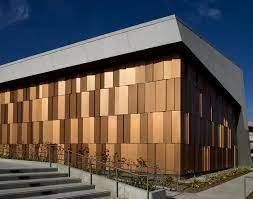
In the heart of Melbourne, a quiet revolution is unfolding in the construction industry. The city is known for its dynamic blend of contemporary and Victorian architecture. Is witnessing a significant shift towards sustainable building practices. This blog delves into why aluminium cladding represents the future of eco-friendly construction in Melbourne. And highlighting its role in propelling the city towards greener, more sustainable urban development.
Aluminium Cladding: A Primer
Before we explore its environmental benefits, let’s understand what aluminium cladding is. Aluminium cladding involves the use of lightweight panels made from aluminium, which are used to cover the exterior of buildings. Known for its durability, resistance to corrosion, and ease of maintenance, aluminium cladding has become a popular choice in the construction industry. Its application is not limited to new buildings but also extends to the refurbishment of older structures, offering them a modern, refreshed look while enhancing their environmental performance.
The Environmental Edge of Aluminium Cladding
1. Energy Efficiency
The material acts as an additional layer of insulation, keeping buildings warmer in winter and cooler in summer. In Melbourne’s variable climate, this attribute is invaluable for creating comfortable, energy-efficient living and working spaces.
2. Durability and Low Maintenance
Aluminium cladding stands out for its remarkable durability. It does not warp, crack, or fade over time, which means it rarely needs to be replaced. This longevity is a key component of sustainable construction, as it minimizes the resource consumption and waste generation associated with frequent renovations or replacements. Moreover, the low maintenance requirement of aluminium cladding further reduces the environmental impact associated with upkeep activities, such as painting and repairs.
3. Recyclability
Perhaps the most significant environmental benefit of aluminium cladding is its recyclability. Aluminium can be recycled indefinitely without losing its quality or properties. This means that once aluminium cladding reaches the end of its life on a building, it can be fully recycled, thus contributing to a circular economy. Melbourne, with its strong focus on sustainability, stands to benefit greatly from embracing materials that support waste reduction and resource efficiency.
4. Lightweight Nature
The lightweight characteristic of aluminium reduces the overall load on building structures. This, in turn, can lead to a reduction in the materials required for the building’s support system, further decreasing the environmental footprint of construction projects. In Melbourne, where innovative construction techniques are highly valued, the use of lightweight materials like aluminium cladding can facilitate more creative architectural designs without compromising on environmental sustainability.
Melbourne’s March Towards Sustainable Construction
Melbourne is already on a path to becoming a greener, more sustainable city. The push towards sustainability is evident in its building codes, which increasingly emphasize energy efficiency, waste reduction, and the use of eco-friendly materials. Aluminium cladding fits perfectly within this framework, offering a solution that not only meets but exceeds these sustainability benchmarks.
The city’s architects and developers are recognizing the benefits of metal cladding, particularly aluminium, in achieving their green building objectives. From residential homes to commercial skyscrapers, aluminium cladding is being chosen for its ability to enhance energy performance, reduce environmental impact, and contribute to the aesthetic diversity of Melbourne’s urban landscape.
The Environmental Edge of Aluminium Cladding
1. Energy Efficiency
One of the most compelling arguments for the use of aluminium cladding in Melbourne’s construction scene is its contribution to energy efficiency. The material acts as an additional layer of insulation, keeping buildings warmer in winter and cooler in summer. In Melbourne’s variable climate, this attribute is invaluable for creating comfortable, energy-efficient living and working spaces.
2. Durability and Low Maintenance
Aluminium cladding stands out for its remarkable durability. It rarely needs replacement because it does not warp, crack, or fade over time. This longevity is a key component of sustainable construction, as it minimizes the resource consumption and waste generation associated with frequent renovations or replacements.
3. Recyclability
Perhaps the most significant environmental benefit of aluminium cladding is its recyclability. Aluminium can be recycled indefinitely without losing its quality or properties. This means that once aluminium cladding reaches the end of its life on a building, it can be fully recycled, thus contributing to a circular economy.
4. Lightweight Nature
The lightweight characteristic of aluminium reduces the overall load on building structures. This, in turn, can lead to a reduction in the materials required for the building’s support system, further decreasing the environmental footprint of construction projects. Melbourne highly values innovative construction techniques, favoring the use of lightweight materials like aluminium cladding to facilitate creative architectural designs while maintaining environmental sustainability.
Melbourne’s March Towards Sustainable Construction
Melbourne is already on a path to becoming a greener, more sustainable city. Aluminium cladding fits perfectly within this framework, offering a solution that not only meets but exceeds these sustainability benchmarks.
The city’s architects and developers are recognizing the benefits of metal cladding, particularly aluminium, in achieving their green building objectives. Aluminium cladding enhances energy performance, reduces environmental impact, and contributes to the aesthetic diversity of Melbourne’s urban landscape, making it a popular choice for residential homes and commercial skyscrapers.
Enhancing Energy Performance
One of the key advantages of aluminium cladding is its ability to enhance the energy performance of buildings. By providing effective insulation, aluminium cladding helps regulate indoor temperatures, reducing the need for excessive heating or cooling. This, in turn, leads to lower energy consumption and decreased carbon emissions, aligning perfectly with Melbourne’s sustainability objectives.
Reducing Environmental Impact
In addition to improving energy efficiency, aluminium cladding also contributes to reducing the environmental impact of construction activities. Unlike traditional building materials that may deplete natural resources or produce harmful by-products, aluminium is highly recyclable and has a low carbon footprint. Its durability ensures longevity, minimizing the need for frequent replacements and reducing construction waste in the long run.




